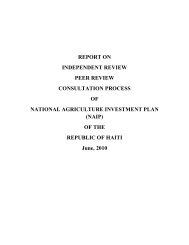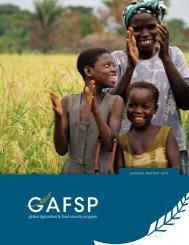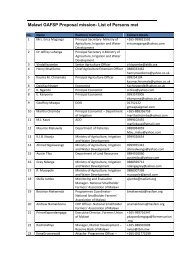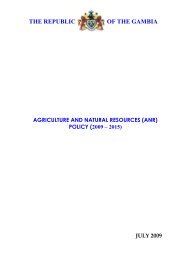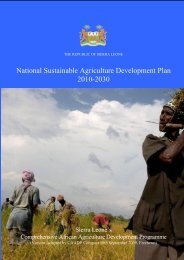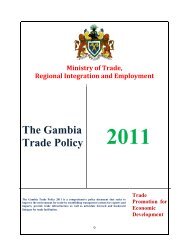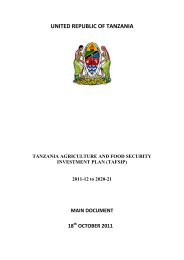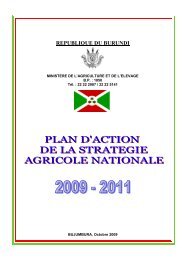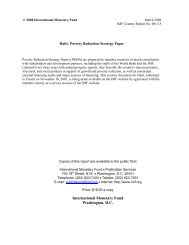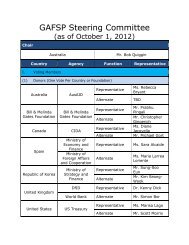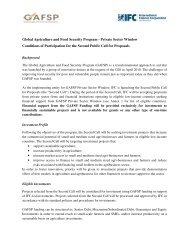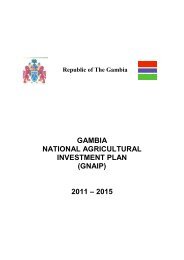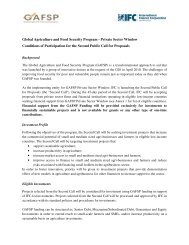World Bank Project Appraisal Document - GAFSP
World Bank Project Appraisal Document - GAFSP
World Bank Project Appraisal Document - GAFSP
Create successful ePaper yourself
Turn your PDF publications into a flip-book with our unique Google optimized e-Paper software.
I. STRATEGIC CONTEXT<br />
A. Country Context<br />
1. Tajikistan is the smallest and poorest of the Central Asian economies, with a population of 7.6<br />
million, of whom 46% live below the poverty line. Robust growth in the last two years has expedited<br />
recovery from the global financial crisis. Real gross domestic product (GDP) grew by 6.5% in 2010<br />
and 7.4% in 2011 in response to a strong recovery of remittance income and increased agricultural<br />
production. Per capita income increased from $US 771 in 2008 to $US 820 in 2010 as a result. The<br />
economy remains highly vulnerable to exogenous shocks nevertheless, including regional trade and<br />
border disputes, volatility in world prices for cotton and aluminum, and the continued crisis in the<br />
euro-zone. Tajikistan’s high dependence on imported fuel and cereal exacerbates this vulnerability,<br />
particularly given the prospect of rising future prices for these commodities and the continued<br />
depreciation of its currency.<br />
2. Prudent fiscal management has ensured that growth in public expenditure remains<br />
commensurate with growth in public revenues, with a budget surplus of 0.5% of GDP (excluding<br />
public investment) in 2011. But with tax revenue of only 20% of GDP the capacity to significantly<br />
increase public expenditure is limited. High levels of external debt, a fragile banking system and low<br />
institutional capacity further constrain the scope for increased public expenditure. Government’s<br />
capacity to respond to adverse events thus remains weak, both in absolute terms and relative to the<br />
needs of the estimated 3.5 million people who live below the poverty line. The capacity to fund public<br />
investment is weak, for the same reasons. This combination of poverty and vulnerability, at both<br />
macro and household level, continues to justify active support from the donor community to achieve<br />
sustainable improvements in food security.<br />
3. With 21% of GDP and 64% of employment, the agriculture sector has a major influence on the<br />
performance of the Tajik economy. The sector accounted for 21% of aggregate economic growth from<br />
2005-2010. 1 But with 77% of Tajikistan’s poor and a high exposure to risk (droughts, floods,<br />
landslides, cotton price volatility, border and trade disputes), agriculture is also one of the most<br />
vulnerable sectors of the economy. Measures to reduce the constraints to agricultural growth and the<br />
sector’s vulnerability to adverse events can thus have a high impact on economic growth and poverty<br />
reduction.<br />
B. Sectoral and Institutional Context<br />
4. Tajikistan’s agricultural resource base is characterized by limited arable land, a heavy reliance<br />
on irrigation for crop production and substantial areas of permanent pasture. Of the 4.1 million<br />
hectares of agricultural land, only 830,000 ha are arable, equivalent to 0.15 ha/capita of the rural<br />
population. Around 85% (720,000 ha) of arable land is irrigated, but only 515,000 ha are currently in<br />
use due to the deterioration of irrigation and drainage infrastructure, water logging and salinization.<br />
Wheat, cotton, fruit and vegetables are the main irrigated crops. Livestock production relies mainly on<br />
forage production and local grazing resources rather than the 3.3 million ha of permanent pasture,<br />
1 <strong>World</strong> <strong>Bank</strong> Indicators, measured in constant (2000) $US<br />
1



